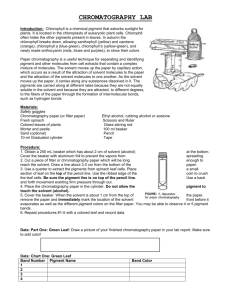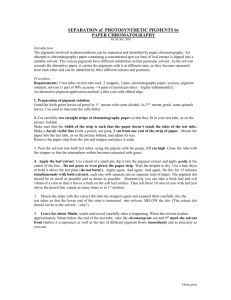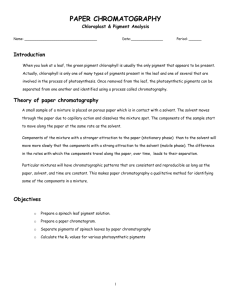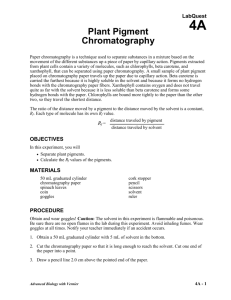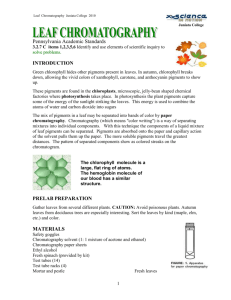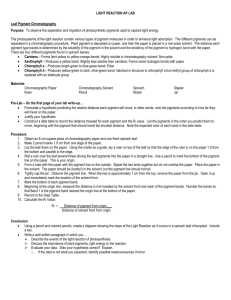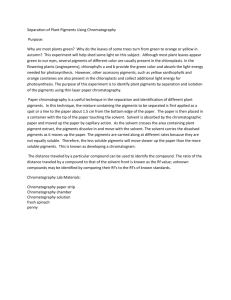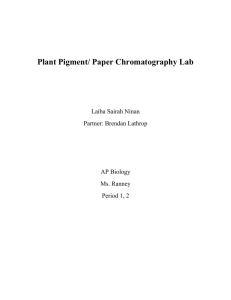R f
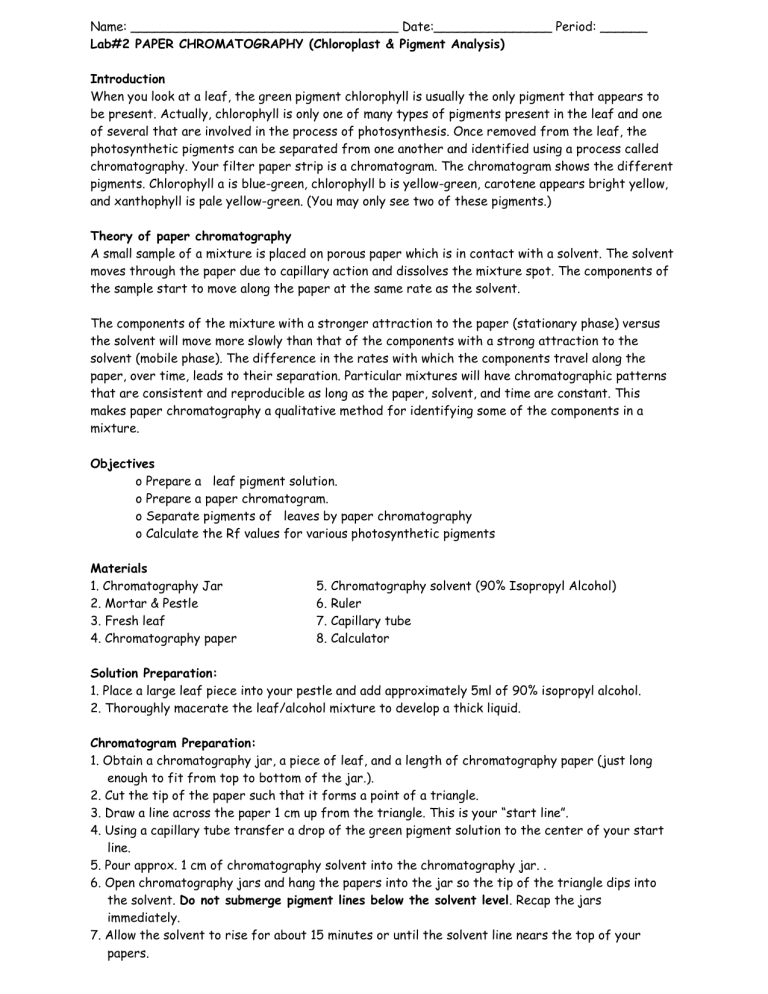
Name: __________________________________ Date:_______________ Period: ______
Lab#2 PAPER CHROMATOGRAPHY (Chloroplast & Pigment Analysis)
Introduction
When you look at a leaf, the green pigment chlorophyll is usually the only pigment that appears to be present. Actually, chlorophyll is only one of many types of pigments present in the leaf and one of several that are involved in the process of photosynthesis. Once removed from the leaf, the photosynthetic pigments can be separated from one another and identified using a process called chromatography. Your filter paper strip is a chromatogram. The chromatogram shows the different pigments. Chlorophyll a is blue-green, chlorophyll b is yellow-green, carotene appears bright yellow, and xanthophyll is pale yellow-green. (You may only see two of these pigments.)
Theory of paper chromatography
A small sample of a mixture is placed on porous paper which is in contact with a solvent. The solvent moves through the paper due to capillary action and dissolves the mixture spot. The components of the sample start to move along the paper at the same rate as the solvent.
The components of the mixture with a stronger attraction to the paper (stationary phase) versus the solvent will move more slowly than that of the components with a strong attraction to the solvent (mobile phase). The difference in the rates with which the components travel along the paper, over time, leads to their separation. Particular mixtures will have chromatographic patterns that are consistent and reproducible as long as the paper, solvent, and time are constant. This makes paper chromatography a qualitative method for identifying some of the components in a mixture.
Objectives o Prepare a leaf pigment solution. o Prepare a paper chromatogram. o Separate pigments of leaves by paper chromatography o Calculate the Rf values for various photosynthetic pigments
Materials
1. Chromatography Jar
2. Mortar & Pestle
3. Fresh leaf
4. Chromatography paper
5. Chromatography solvent (90% Isopropyl Alcohol)
6. Ruler
7. Capillary tube
8. Calculator
Solution Preparation:
1. Place a large leaf piece into your pestle and add approximately 5ml of 90% isopropyl alcohol.
2. Thoroughly macerate the leaf/alcohol mixture to develop a thick liquid.
Chromatogram Preparation:
1. Obtain a chromatography jar, a piece of leaf, and a length of chromatography paper (just long enough to fit from top to bottom of the jar.).
2. Cut the tip of the paper such that it forms a point of a triangle.
3. Draw a line across the paper 1 cm up from the triangle. This is your “start line”.
4. Using a capillary tube transfer a drop of the green pigment solution to the center of your start line.
5. Pour approx. 1 cm of chromatography solvent into the chromatography jar. .
6. Open chromatography jars and hang the papers into the jar so the tip of the triangle dips into the solvent. Do not submerge pigment lines below the solvent level. Recap the jars immediately.
7. Allow the solvent to rise for about 15 minutes or until the solvent line nears the top of your papers.
8. When the solvent line is about 1cm from the top of your paper. Remove the papers and mark the
farthest point of the solvent's progress before this line evaporates.
9. Allow the filter papers to dry, and then make a sketch of the chromatogram. Some possible colors and the pigments they represent are: o Faint yellow - carotenes o Yellow - xanthophylls o Bright green - chlorophyll a o Red - anthocyanin
10. Measure the distance from the start point to the front line and each of the pigment lines.
Record these measurements in the data table. Calculate the Rf values for each pigment according to the following formula;
Distance moved by the pigment
(Distance from the pigment origin to the pigment front)
R f
=
Distance moved by the solvent
(Distance from pigment origin to solvent front)
Observations/Data (10pts)
Line
1
Color Probable
Pigment
Distance
Traveled from start
Rf Value
During winter, there is not enough light or
2 water for photosynthesis. The trees will rest, and live off the food they stored during the summer. They begin to shut
3
4 down their food-making factories. The green chlorophyll disappears from the leaves. As the bright green fades away, we begin to see yellow and orange colors.
Small amounts of these colors have been in the leaves all along. We just can't see them in the summer, because they are covered up
5
(Front)
On a separate sheet of paper
Hypothesis (if…then statement) (2pts)
Analysis/Conclusion (5pts)
1. How many pigments were found in the leaf? by the green chlorophyll.
The bright reds and purples we see in leaves are made mostly in the fall. In some trees, like maples, glucose is trapped in the leaves after photosynthesis stops. Sunlight and the cool nights of autumn cause the leaves turn this glucose into a red color.
The brown color of trees like oaks is made from wastes left in the leaves.
2. Which of these pigments would be considered the most polar (most like water)?
3. Which one the least polar?
4. Many trees have leaves that are green in the summer and red, yellow, or orange in autumn. Where were these colors during the summer? How can they suddenly appear in autumn?
5. In addition to separating plant pigments, what are some other possible applications for paper chromatography?

